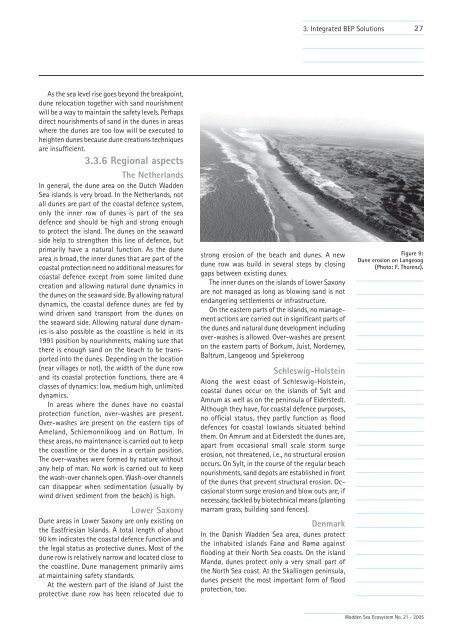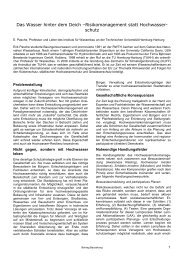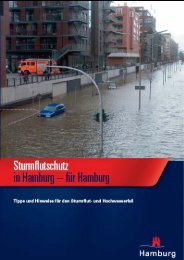Coastal Protection and Sea Level Rise - Hochwasser
Coastal Protection and Sea Level Rise - Hochwasser
Coastal Protection and Sea Level Rise - Hochwasser
Create successful ePaper yourself
Turn your PDF publications into a flip-book with our unique Google optimized e-Paper software.
3. Integrated BEP Solutions<br />
27<br />
As the sea level rise goes beyond the breakpoint,<br />
dune relocation together with s<strong>and</strong> nourishment<br />
will be a way to maintain the safety levels. Perhaps<br />
direct nourishments of s<strong>and</strong> in the dunes in areas<br />
where the dunes are too low will be executed to<br />
heighten dunes because dune creations techniques<br />
are insufficient.<br />
3.3.6 Regional aspects<br />
The Netherl<strong>and</strong>s<br />
In general, the dune area on the Dutch Wadden<br />
<strong>Sea</strong> isl<strong>and</strong>s is very broad. In the Netherl<strong>and</strong>s, not<br />
all dunes are part of the coastal defence system,<br />
only the inner row of dunes is part of the sea<br />
defence <strong>and</strong> should be high <strong>and</strong> strong enough<br />
to protect the isl<strong>and</strong>. The dunes on the seaward<br />
side help to strengthen this line of defence, but<br />
primarily have a natural function. As the dune<br />
area is broad, the inner dunes that are part of the<br />
coastal protection need no additional measures for<br />
coastal defence except from some limited dune<br />
creation <strong>and</strong> allowing natural dune dynamics in<br />
the dunes on the seaward side. By allowing natural<br />
dynamics, the coastal defence dunes are fed by<br />
wind driven s<strong>and</strong> transport from the dunes on<br />
the seaward side. Allowing natural dune dynamics<br />
is also possible as the coastline is held in its<br />
1991 position by nourishments, making sure that<br />
there is enough s<strong>and</strong> on the beach to be transported<br />
into the dunes. Depending on the location<br />
(near villages or not), the width of the dune row<br />
<strong>and</strong> its coastal protection functions, there are 4<br />
classes of dynamics: low, medium high, unlimited<br />
dynamics.<br />
In areas where the dunes have no coastal<br />
protection function, over-washes are present.<br />
Over-washes are present on the eastern tips of<br />
Amel<strong>and</strong>, Schiemonnikoog <strong>and</strong> on Rottum. In<br />
these areas, no maintenance is carried out to keep<br />
the coastline or the dunes in a certain position.<br />
The over-washes were formed by nature without<br />
any help of man. No work is carried out to keep<br />
the wash-over channels open. Wash-over channels<br />
can disappear when sedimentation (usually by<br />
wind driven sediment from the beach) is high.<br />
Lower Saxony<br />
Dune areas in Lower Saxony are only existing on<br />
the Eastfriesian Isl<strong>and</strong>s. A total length of about<br />
90 km indicates the coastal defence function <strong>and</strong><br />
the legal status as protective dunes. Most of the<br />
dune row is relatively narrow <strong>and</strong> located close to<br />
the coastline. Dune management primarily aims<br />
at maintaining safety st<strong>and</strong>ards.<br />
At the western part of the isl<strong>and</strong> of Juist the<br />
protective dune row has been relocated due to<br />
strong erosion of the beach <strong>and</strong> dunes. A new<br />
dune row was build in several steps by closing<br />
gaps between existing dunes.<br />
The inner dunes on the isl<strong>and</strong>s of Lower Saxony<br />
are not managed as long as blowing s<strong>and</strong> is not<br />
endangering settlements or infrastructure.<br />
On the eastern parts of the isl<strong>and</strong>s, no management<br />
actions are carried out in significant parts of<br />
the dunes <strong>and</strong> natural dune development including<br />
over-washes is allowed. Over-washes are present<br />
on the eastern parts of Borkum, Juist, Norderney,<br />
Baltrum, Langeoog und Spiekeroog<br />
Schleswig-Holstein<br />
Along the west coast of Schleswig-Holstein,<br />
coastal dunes occur on the isl<strong>and</strong>s of Sylt <strong>and</strong><br />
Amrum as well as on the peninsula of Eiderstedt.<br />
Although they have, for coastal defence purposes,<br />
no official status, they partly function as flood<br />
defences for coastal lowl<strong>and</strong>s situated behind<br />
them. On Amrum <strong>and</strong> at Eiderstedt the dunes are,<br />
apart from occasional small scale storm surge<br />
erosion, not threatened, i.e., no structural erosion<br />
occurs. On Sylt, in the course of the regular beach<br />
nourishments, s<strong>and</strong> depots are established in front<br />
of the dunes that prevent structural erosion. Occasional<br />
storm surge erosion <strong>and</strong> blow outs are, if<br />
necessary, tackled by biotechnical means (planting<br />
marram grass, building s<strong>and</strong> fences).<br />
Denmark<br />
In the Danish Wadden <strong>Sea</strong> area, dunes protect<br />
the inhabited isl<strong>and</strong>s Fanø <strong>and</strong> Rømø against<br />
flooding at their North <strong>Sea</strong> coasts. On the isl<strong>and</strong><br />
M<strong>and</strong>ø, dunes protect only a very small part of<br />
the North <strong>Sea</strong> coast. At the Skallingen peninsula,<br />
dunes present the most important form of flood<br />
protection, too.<br />
Figure 9:<br />
Dune erosion on Langeoog<br />
(Photo: F. Thorenz).<br />
Wadden <strong>Sea</strong> Ecosystem No. 21 - 2005




